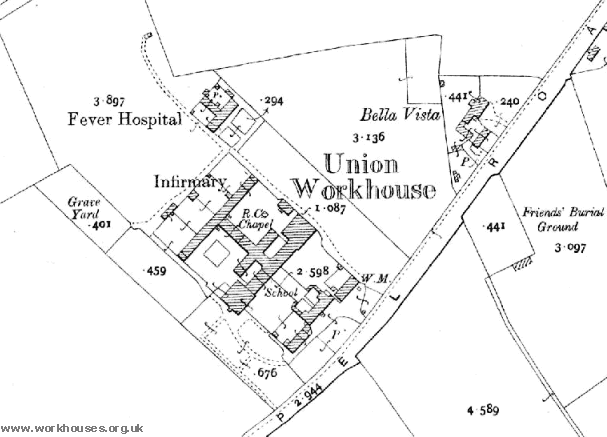Edenderry, Co. Offaly (King's County)
Edenderry Poor Law Union was formally declared on the 7th May 1839 and covered an area of 290 square miles. Its operation was overseen by an elected Board of Guardians, 22 in number, representing its 17 electoral divisions as listed below (figures in brackets indicate numbers of Guardians if more than one):
King's County: Ballinakill, Ballyburly, Ballymacwilliam, Clonmore, Clonsast (2), Croghan, Edenderry (3).
Co. Kildare: Ardkill, Ballynadrimna, Cadamstown, Carbury, Cloncurry, Mylerstown, Rathangan (2).
Co. Meath: Ballyboggan, Castlejordan, Clonard (2).
The Board also included 7 ex-officio Guardians, making a total of 29. The Guardians met each week on Saturday.
The population falling within the Union at the 1831 census had been 35,536 with divisions ranging in size from Ballinakill (population 1,081) to Edenderry itself (4,535).
The new Edenderry Union workhouse was erected on a six-acre site half a mile to the south-west of Edenderry. Designed by the Poor Law Commissioners' architect George Wilkinson, the building was based on one of his standard plans to accommodate 600 inmates. Its construction cost £5,300 plus £1,110 for fittings etc. The workhouse was declared fit for the reception of paupers on 21st December 1841, and received its first admissions on 19th March 1842. The workhouse location and layout are shown on the 1909 map below.

Edenderry workhouse site, 1909
The buildings followed Wilkinson's typical layout. An entrance and administrative block at the south-east of the site contained a porter's room and waiting room at the centre with the Guardians' board room on the first floor above.
The main accommodation block had the Master's quarters at the centre, with male and female wings to each side. At the rear, a range of single-storey utility rooms such as bakehouse and washhouse connected through to the infirmary and idiots' wards via a central spine containing the chapel and dining-hall.
During the famine in the mid-1840s, a 40-bed fever hospital was erected at the north of the workhouse.
In 1895, Edenderry was visited by a "commission" from the British Medical Journal investigating conditions in Irish workhouse infirmaries. Their report, which catalogued may deficiencies, made a number recommendations including an increase in the number of trained nurses; improvements in the care of the infirm such as more warmth and light and better ventilation; the dispersal of harmless lunatics among the other inmates; and the provision of hot and cold water, baths, and indoor toilets. Further details are available in the full report.
In 1903, five nuns were being employed at the workhouse: four as nurses and one as matron.
After the creation of the Irish Free State in 1922, the workhouse was closed but the fever hospital was redployed as a District Hospital.
Cyril O'Neil, who was born in the former workhouse, recalls:
I am not sure as to when the building ceased to be used as a workhouse but I presume it was in the early part of the 20th century. In my very early youth, I remember sections of the building being used for various purposes, a section housed a school, the Irish Army used a good portion of it, a company who manufactured truck bodies was also accommodated there, and the local authority had a road maintenance depot there.
I would have played throughout the building and remember it kindly. There were two or three very deep wells which supplied the water, some of the big pumps had rusted but were still in situ. I remember many carvings of horses, fish etc. on some of the granite stonework but this was all disposed of when the demolition was completed. I remember, during the demolition, trying to get some of these stones for posterity, but was too young at the time to have any influence.
Records
Note: many repositories impose a closure period of up to 100 years for records identifying individuals. Before travelling a long distance, always check that the records you want to consult will be available.
- Offaly Archives, Offaly Archives Unit 1F, Axis Business Park, Clara Road, Tullamore, Co Offaly.
Bibliography
- Crossman, V (2006) Politics, Pauperism and Power in Late Nineteenth-century Ireland
- Gray, P (2009) The Making of the Irish Poor Law, 1815-43
- O'Connor, J (1995) The Workhouses of Ireland
Links
- None.
Unless otherwise indicated, this page () is copyright Peter Higginbotham. Contents may not be reproduced without permission.


